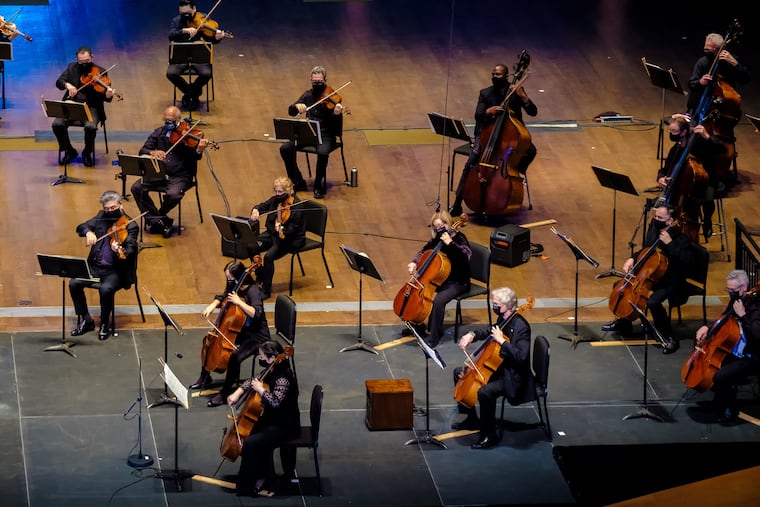Philadelphia Orchestra’s Digital Stage series learns from the shortcomings of others
The 55-minute show of Schubert and Beethoven (shot in recent weeks at the Mann Center for the Performing Arts) is, in its way, a wholly legitimate concert experience.

Conveying symphonic grandeur in the reduced-orchestra circumstance of COVID-dominated times is the central challenge of any video concert season. The Philadelphia Orchestra has arrived somewhat late to that party in its Sight/Sound/Symphony program that opens the orchestra’s streamed Digital Stage series at 8 p.m. Thursday, but having learned well from the shortcomings of others.
The Berlin Philharmonic and Czech Philharmonic, to name only two, delivered musically thin and visually uninteresting programs as Europe re-started its concerts. But not the Philadelphia Orchestra.
Even without the help of star soloists, music director Yannick Nézet-Séguin, visual designer Refik Anadol, and program producer Panavista Inc. (known for PBS' Articulate) have created a 55-minute show of Schubert and Beethoven (shot in recent weeks at the Mann Center for the Performing Arts) that is, in its way, a wholly legitimate concert experience.
But an intriguingly strange-looking one: The expanse of the Mann’s stage looks like some hip warehouse theater in Berlin. With black masks and plexi-glass partitions, the concert might be mistaken for an art installation in pre-COVID times.
Elements that could’ve gone quite wrong do not. The Anadol visual interpretation of Beethoven’s Symphony No. 7 (second movement) involves Beethoven-era architecture being rendered into long, arched hallways. Whether or not you welcome it (I am somewhere in the middle), the tempo of the images is in perfect synch with the music so there is no competition or dissonance between video and audio.
Carlos Simon’s new piece Fate Now Conquers, commissioned by the Philadelphia Orchestra, is based on the same Beethoven movement. But what could easily be an annoying piggyback piece (the sort that makes me want to yell “Write your own stuff, dammit!”) is actually a perfectly engaging, propulsive, middle-weight concert opener that, to my ears, is 90% Simon.
Yes, Beethoven’s melody is heard in elongated form, sometimes framing the nervous rhythms, but ones that owe more to John Adams than to Beethoven. In fact, Simon ought to add more movements.
Lovable as it is, Schubert Symphony No. 8 (“Unfinished”) can leave you asking if there’s anything new to discover in this blessedly straightforward piece. But, yes, there is here. Nézet-Séguin’s tempos are slow-ish but hardly leisurely: The music suggests a descent into the underworld in the first movement, and an emergence from it in the second movement that is steeped in resignation and sorrow.
Though Schubert’s orchestration isn’t particularly coloristic, the strings lower their vibratos, creating an eloquently pale sound that allows other instruments in the texture to come through more clearly. The many incidental solos are played with great expressivity.
That impact is underscored by the video production’s camera work, which moves in slow, sweeping lines (completely attuned to the music) that may not have been possible in a public concert where cameras would be obtrusive for the audience. All the right solos are spotlighted. Nézet-Séguin’s Beethoven concerts with his Orchestre Metropolitain of Montreal are similarly engaging, but not on this level.
One last thing: Don’t turn off after Schubert. There’s an encore.
The Sight/Sound/Symphony program
8 p.m. Thursday, available on demand for 72 hours for ticket holders. Digital tickets are $15 and available through PhilOrch.org.